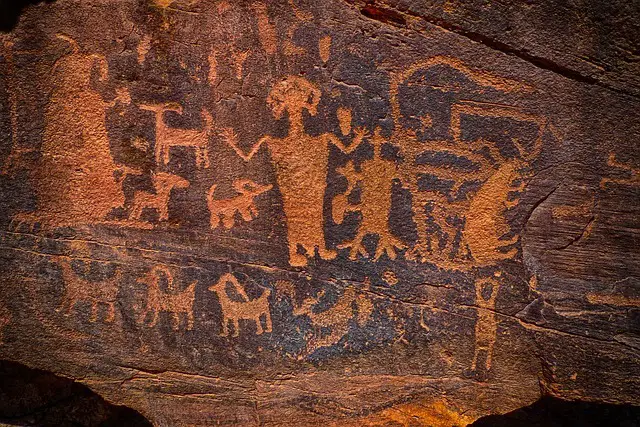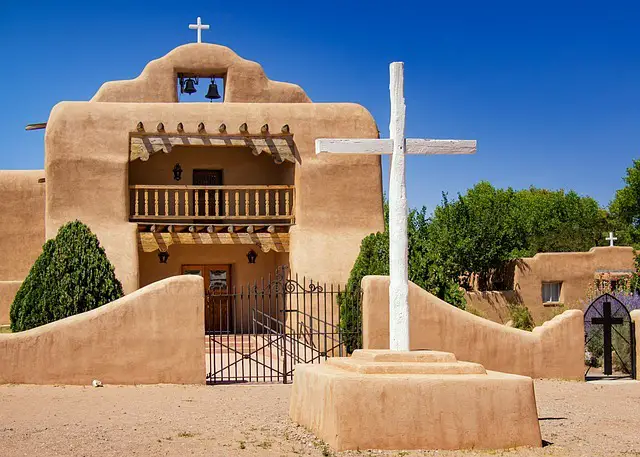Have you ever wondered about the rich and vibrant Native American culture that thrives in the American Southwest? Well, I certainly have! From the intricate art and crafts to the fascinating traditions and rituals, there is so much to explore and learn about. In this article, we’ll delve into the diverse tribes that call this region home, their unique customs, and the incredible history that has shaped their way of life. Get ready to embark on a journey through time and discover the rich tapestry of Native American culture in the American Southwest!
When it comes to Native American culture, the American Southwest is truly a treasure trove. This region is home to various tribes, each with their own distinct traditions and customs. From the Hopi and Navajo in Arizona to the Pueblo and Apache in New Mexico, there is a rich tapestry of cultures to uncover. The Southwest is also known for its stunning landscapes, which have played a significant role in shaping the spiritual beliefs and rituals of these tribes. Throughout this article, we’ll take a closer look at the fascinating customs, sacred sites, and artistic expressions that make up the unique Native American culture in the American Southwest. So, let’s dive deeper into this remarkable world and discover the rich heritage that awaits us!

Introduction
As I meander through the vast and diverse landscape of the American Southwest, I am drawn to the rich tapestry of Native American culture that has flourished in this region for centuries. From the resilient Navajo Tribe to the mysterious Zuni Tribe, the Southwest is home to numerous tribes, each with their unique traditions, beliefs, and contributions. In this article, I will embark on a journey to explore Native American culture in the American Southwest, delving into the tribes, historical background, traditional arts and crafts, spirituality, clothing, customs, challenges, and the future outlook. Join me as we unravel the essence of these ancient traditions that continue to shape the Southwest today.
Native American Tribes in the American Southwest
Navajo Tribe
The Navajo Tribe, also known as Diné, is one of the largest Native American tribes in the United States. Their homeland spans across the states of Arizona, New Mexico, and Utah. With a population of over 300,000, the Navajo have managed to preserve their language, traditions, and sacred sites despite the impacts of colonization and modernization. Their intricate rug weaving, beautiful jewelry, and vibrant artwork reflect the deep connection they share with their land and cultural identity.
Hopi Tribe
Situated in northeastern Arizona, the Hopi Tribe is renowned for their pottery and Kachina dolls. The Hopi have inhabited this region for over a millennium and have developed a complex and highly spiritual society. Their pottery bears intricate designs and symbolism, illustrating their deep understanding of the natural world and their respect for the celestial powers. Kachina dolls, on the other hand, play a significant role in Hopi religious ceremonies, representing various spirits and deities.
Pueblo Tribes
The Pueblo Tribes, including the Acoma, Hopi, Zuni, and Taos Pueblos, are indigenous communities found in the Southwest region. These tribes have resided in the area for centuries, building elaborate adobe structures and engaging in a range of traditional activities. The Pueblo people are known for their exquisite jewelry, vibrant dances, and enduring pottery-making techniques. Their kivas, underground ceremonial chambers, serve as sacred spaces for spiritual practices and communal gatherings.
Apache Tribe
The Apache Tribe is composed of several distinct groups, including the Western Apache, Chiricahua Apache, Jicarilla Apache, and Mescalero Apache. Known for their fierce warrior traditions, these tribes have a rich cultural heritage deeply intertwined with the rugged landscape of the Southwest. Apache craftsmanship is characterized by intricate beadwork, basketry, and traditional clothing adorned with vibrant patterns and symbols. The strength and resilience of the Apache people can be witnessed in their renowned traditional dances, which have preserved their stories and history for generations.
Zuni Tribe
Located in western New Mexico, the Zuni Tribe has a rich artistic tradition steeped in spirituality. Their intricate stone carvings, known as fetishes, hold a sacred significance in Zuni culture, representing the spirits of animals and ancestors. Additionally, Zuni pottery distinguishes itself through its remarkable geometric designs and skilled craftsmanship. The Zuni people’s deep reverence for their ancestors and the natural world is evident in their cultural practices, including the annual Shalako festival, a ceremony performed to bring prosperity and ensure the well-being of the community.
Tohono O’odham Tribe
The Tohono O’odham Tribe, commonly known as the Desert People, resides in both Arizona and Sonora, Mexico. Their territory encompasses the Sonoran Desert, an environment that has shaped their way of life for centuries. One of their most renowned cultural traditions is the art of basket weaving, using locally sourced materials such as bear grass and yucca leaves. Additionally, the Tohono O’odhamare are known for their vibrant and intricate beadwork, showcasing a mastery of traditional craftsmanship.
Yavapai-Apache Nation
The Yavapai-Apache Nation is a federally recognized tribe located in central Arizona. Comprised of two distinct indigenous groups, the Yavapai and the Apache, this tribe has a vibrant cultural heritage deeply rooted in the Southwest. Their basketry, passed down through generations, is characterized by detailed patterns woven from local natural materials. The Yavapai-Apache Nation also boasts a rich oral tradition, preserving their history and knowledge through storytelling and song.
Historical Background of Native American Culture
Prehistoric Origins of Native American Culture in the Southwest
Before European exploration and settlement, Native American culture thrived in the Southwest for thousands of years. The ancestors of the present-day tribes inhabited this region, leaving behind a rich archeological record of their existence. Ancient cliff dwellings, such as the ones found in Mesa Verde National Park, reveal the ingenuity and architectural prowess of these early Southwest inhabitants. The Ancestral Puebloans, also known as the Anasazi, established agricultural societies and traded goods across vast distances, leaving behind a lasting influence on the cultural practices of contemporary Native American tribes.
Impact of Spanish Conquest on Native American Culture
The arrival of Spanish explorers in the 16th century marked a turning point in Native American culture in the Southwest. The Spanish sought to convert Native Americans to Christianity and colonize the region, bringing with them new cultural, religious, and economic practices. This period of colonization resulted in a complex blending of Indigenous and European traditions, known as the Spanish Colonial period. Native American tribes were forced to adapt to new ways of life while still attempting to preserve their cultural identity and traditions.
The Role of Native American Tribes in the American Revolution
During the American Revolution in the late 18th century, Native American tribes in the Southwest played a pivotal role in shaping the outcome of the conflict. The Navajo, Apache, and other tribes formed alliances with both the British and American forces, strategically choosing sides to protect their lands and sovereignty. These tribal alliances and tactics proved essential in securing military advantages and negotiating treaties that would influence the future of Native American tribes in the Southwest.
Native American Cultural Resilience During the American Civil War
The American Civil War in the mid-19th century brought further challenges and disruptions to Native American tribes in the Southwest. Despite the turmoil, Native American communities in the region demonstrated incredible resilience by adapting to the changing political and social landscape. They continued to engage in traditional practices, preserve their languages, and forge connections with other tribes to defend their rights and maintain their cultural identities.
Government Policies and their Effects on Native American Culture
The imposition of government policies, such as the Indian Removal Act and the reservation system, had a profound impact on Native American tribes in the Southwest. These policies often resulted in the displacement of tribes from their ancestral lands and the forced assimilation into Euro-American society. Nevertheless, Native American communities have persevered and continue to assert their sovereignty, revitalize their cultures, and fight for their rights and recognition.
Traditional Arts and Crafts
Pottery and Pottery Techniques
Pottery holds a special place in Native American culture, serving both utilitarian and artistic purposes. The Southwest is renowned for its distinctive pottery traditions, with each tribe having their unique styles and techniques. The Acoma Pueblo, for example, are known for their intricate hand-painted designs on white pottery, while the Hopi specialize in black-on-black pottery with intricate symbolism. Techniques such as coiling, shaping, painting, and firing are passed down through generations, preserving the ancient art of pottery-making.
Weaving and Techniques of Native American Textiles
Weaving is another integral part of Native American culture, particularly in the Southwest. The Navajo people, in particular, have a long history of weaving intricate rugs and blankets using traditional techniques. These textiles often feature vibrant colors and geometric patterns, reflecting the landscape and cultural symbolism. Sheep wool, handspun and dyed with natural materials, is used to create these artistic masterpieces. The intricate craftsmanship involved in weaving is a testament to the enduring traditions and skills passed down through generations.
Kachina Dolls and their Significance
Kachina dolls play a prominent role in the spiritual and cultural practices of several Southwest tribes, notably the Hopi and Zuni. These dolls, carved out of cottonwood root, represent various spirits and deities integral to tribal mythology and religious ceremonies. Kachina dolls serve as educational tools for teaching tribal history, values, and traditions, ensuring the transmission of cultural knowledge from one generation to the next. These intricately crafted dolls have become highly sought-after collectibles, showcasing the artistic talents and cultural significance of the Southwest tribes.
Native American Jewelry: Traditional Designs and Materials
Native American jewelry is renowned worldwide for its exquisite craftsmanship and incorporation of natural materials. Silverwork and turquoise gemstones are hallmarks of Native American jewelry, with the Navajo and Zuni tribes particularly renowned for their intricate designs. Turquoise, believed to bring protection and good fortune, is often incorporated into necklaces, bracelets, earrings, and rings. Additionally, Native American jewelry often features other materials such as coral, shell, and various colorful gemstones, highlighting the vibrant natural resources abundant in the Southwest.
Storytelling and Oral Tradition
Storytelling and oral tradition have been fundamental to Native American culture for generations. Through stories, legends, and myths, tribes pass on their history, knowledge, and values from one generation to the next. The oral tradition is intertwined with ceremonial practices, creating a powerful and spiritual connection to ancestral wisdom. Native American storytelling often incorporates song, dance, and visual arts, allowing for a multi-sensory experience that reinforces the cultural fabric of the Southwest tribes.

Spirituality and Belief Systems
Native American Creation Myths and Legends
Native American tribes in the Southwest possess intricate creation myths and legends that explain the origins of the world and the relationship between humans and nature. These narratives often feature powerful deities, heroic figures, and celestial beings who shape the natural world and provide guidance to the tribe. Creation myths and legends not only serve as explanations for natural phenomena but also reinforce the interconnectedness between humans and the environment, emphasizing the importance of respecting and preserving the land and its resources.
Sacred Sites and Ritual Practices
Sacred sites hold deep cultural and spiritual significance for Native American tribes in the Southwest. These sites, often found in natural landscapes such as mountains, canyons, or springs, are believed to be imbued with spiritual energy and the presence of ancestral spirits. Native American tribes partake in rituals and ceremonies at these sites, seeking guidance, healing, and connection with their spiritual heritage. Respect for sacred sites is essential in Native American culture, ensuring the preservation of these vital places for future generations.
Shamanism and Healing Traditions
Shamanism, or spiritual healing practices, play a central role in Native American culture in the Southwest. Shamans, often revered members of the tribe, act as intermediaries between the natural and spiritual worlds, using various rituals, herbs, and chants to promote physical, emotional, and spiritual well-being. These healing traditions encompass a holistic approach, recognizing the interconnectedness of mind, body, and spirit. Some tribes still practice traditional healing methods today, showcasing the continued relevance and effectiveness of these ancient techniques.
The Importance of Nature and Land in Native American Spirituality
Nature and the land hold immense importance in Native American spirituality. The Southwest’s awe-inspiring landscapes, from desert mesas to breathtaking canyons, have shaped the cultural and spiritual beliefs of Native American tribes. The land is seen as a living entity, deserving of respect and reverence. Native American spirituality emphasizes the interconnectedness between humans and nature, with tribes acknowledging their role as stewards of the land. This deep connection to the natural world underlies their cultural practices and their commitment to protecting the environment for future generations.
Traditional Clothing and Attire
Garments and Materials Used in Native American Clothing
Traditional Native American clothing in the Southwest reflects the natural resources and climatic conditions of the region. Each tribe has its distinct style, materials, and patterns. The Navajo, for example, are known for their elegant and colorful velvet dresses, adorned with elaborate silver jewelry. The Apache, on the other hand, traditionally wore leather clothing with intricate beadwork and fringe. These garments were not only functional but also served as expressions of cultural identity and pride.
Traditional Tribal Regalia and Ceremonial Attire
Ceremonial attire is a crucial element of Native American culture in the Southwest. Each tribe has its unique regalia and ceremonial clothing to signify specific rituals and events. Feather headdresses, adorned with intricate beadwork, shells, and feathers, are particularly significant. These headdresses symbolize bravery, honor, and spiritual connection. Traditional dances such as the powwow provide a platform for tribal members to showcase their regalia, perpetuating cultural traditions and celebrating their rich heritage.
The Evolution of Native American Fashion in Contemporary Society
Native American fashion has experienced both appreciation and appropriation in contemporary society. The vibrant colors, intricate patterns, and natural materials used in traditional Native American clothing have influenced mainstream fashion. However, it is essential to recognize and respect the cultural significance of these designs and their origins. Many Native American artists and designers are working to reclaim and redefine Native American fashion, ensuring that the traditions and cultural heritage are honored rather than commodified.

Cultural Traditions and Customs
Celebrations and Festivals
The Southwest is a region known for its vibrant celebrations and festivals, which are rich in Indigenous traditions. Powwows, for example, are gatherings that bring together Native American tribes from various regions, showcasing their dances, regalia, music, and artwork. The Gathering of Nations, held annually in Albuquerque, New Mexico, is one of the largest powwows in North America. Other celebratory events, such as the Acoma Pueblo’s Feast Day and the Zuni Shalako Festival, provide opportunities for tribal members to come together, strengthen cultural bonds, and express gratitude for their heritage.
Native American Dance and Music
Dance and music serve as integral components of Native American culture, conveying stories, histories, and spiritual connections. Each tribe has its unique dance styles and music, characterized by distinct rhythms, instrumentation, and movements. From the intricate footwork of the Apache Crown Dance to the graceful movements of the Hopi Butterfly Dance, these traditional forms of expression preserve cultural values and traditions. Today, Native American dance and music continue to thrive, with many performances open to the public, allowing for cultural exchange and appreciation.
Social Structure and Kinship Systems
Native American tribes in the Southwest have complex social structures and kinship systems that foster communal harmony and intergenerational connections. Respect for elders and the wisdom they possess is deeply ingrained in these societies. Kinship ties are often extended beyond immediate family members, with tribal members considering each other as honorary relatives. This interconnectedness promotes a sense of unity and belonging, essential for the preservation of Native American culture and the passing down of cultural knowledge.
Traditional Food and Cuisine
Native American cuisine is a reflection of the region’s biodiversity and the tribes’ deep connection to the land. Staple foods such as corn, beans, squash, and various wild game have sustained tribes for generations. Native American cooking techniques, such as pit cooking and the use of traditional clay ovens called horno, are still practiced today. Traditional meals are often accompanied by communal feasts and social gatherings, reinforcing the values of sharing, cooperation, and gratitude for the abundance provided by the land.
Challenges and Preservation of Native American Culture
Cultural Appropriation and Misrepresentation
One of the greatest challenges faced by Native American tribes in the Southwest is the rampant cultural appropriation and misrepresentation of their traditions and symbols. Native American art, clothing, and spiritual practices have been commodified and exploited by mainstream culture. This appropriation strips away the cultural significance and sacredness of these practices, reducing them to mere fashion trends or marketing tools. It is crucial for individuals and companies to educate themselves, respect cultural boundaries, and support Native American artists and communities.
Efforts for Cultural Preservation and Revitalization
Despite numerous challenges, Native American tribes in the Southwest are actively working to preserve and revitalize their cultural traditions. Language revitalization programs, traditional arts and crafts apprenticeships, and cultural education initiatives are just a few examples of these efforts. Native American communities are reclaiming their language, reviving traditional ceremonies, and promoting cultural awareness within their tribes and broader society. By fostering intergenerational connections and engaging in cultural preservation activities, Native American tribes are ensuring the survival and continuity of their culture.
Impact of Tourism on Native American Culture
The rise in tourism to the Southwest has presented both opportunities and challenges for Native American tribes. On one hand, tourism offers economic development opportunities and a chance to share their culture with the world. Many tribes operate cultural centers, museums, and guided tours that allow visitors to learn about their traditions firsthand. However, tourism can also exert pressure on sacred sites, disrupt traditional practices, and perpetuate stereotypes. It is crucial for travelers to engage in responsible and respectful tourism, supporting Native American businesses and respecting cultural boundaries.
The Role of Education in Promoting Native American Culture
Education plays a vital role in promoting understanding and respect for Native American culture in the Southwest. Incorporating accurate and comprehensive Native American history and culture into school curricula is crucial in combating stereotypes and fostering cultural awareness. Native American scholars and educators are actively working to reshape the narrative and provide accurate representations of their tribes’ history, traditions, and contributions to society. By educating future generations about the rich cultural heritage of Native American tribes, we can foster a more inclusive and respectful society.

Native American Contributions to Society
Native American Influence in Art and Literature
Native American tribes in the Southwest have a profound impact on art and literature. Native American artists have enriched the art world with their unique designs, techniques, and cultural symbolism. Paintings, sculptures, and mixed media art produced by Native American artists often reflect themes of nature, spirituality, and cultural identity. Similarly, Native American literature explores the complexities of Indigenous experiences, the preservation of traditions, and the struggles faced by Native American communities. Through their artistic expressions, Native American artists and writers contribute to the cultural fabric of the Southwest and beyond.
Contributions to Science and Technology
Native American tribes in the Southwest have contributed significantly to the field of science and technology. Traditional agricultural practices, such as the Three Sisters planting system (corn, beans, and squash), demonstrated innovative approaches to sustainable farming. Native American tribes were keen observers of the natural world, possessing extensive knowledge of local plants, animals, and ecosystems. Today, many tribes work in partnership with scientists, integrating traditional ecological knowledge into conservation practices and environmental management.
Native American Impact on Environmental Conservation
Native American tribes in the Southwest have long-standing connections to the land and demonstrate a deep commitment to environmental conservation. The concept of sustainability is ingrained in their cultural practices, recognizing the importance of living in harmony with nature. Many tribes actively participate in environmental advocacy, land stewardship, and the protection of sacred natural sites. By engaging in conservation efforts, Native American communities are forging connections between cultural preservation and environmental sustainability, reinforcing the vital role of Indigenous knowledge and practices in protecting the Southwest’s unique ecosystems.
Native American Language and Linguistic Diversity
The Richness of Native American Languages in the Southwest
The Southwest is home to a rich diversity of Native American languages, each reflecting the unique cultural heritage of the tribes. Navajo, Hopi, Zuni, and Apache are just a few of the languages spoken in the region. These languages are more than just a means of communication; they encapsulate the cultural worldview, values, and traditions of the tribes. However, many Native American languages are endangered, with fewer fluent speakers remaining. Language revitalization programs and efforts to incorporate Indigenous languages into educational systems are essential in preserving this linguistic diversity.
Language Preservation Efforts and Revitalization Programs
Recognizing the critical importance of language preservation, Native American tribes and organizations have undertaken various initiatives to revitalize their languages. Language immersion schools, community language classes, and intergenerational language programs seek to reclaim and pass down the Native American languages to younger generations. These efforts foster cultural pride, strengthen community bonds, and ensure the preservation of this essential aspect of Native American culture.

Treaties and Legal Issues
Historical Treaties Between Native American Tribes and the U.S. Government
Throughout history, Native American tribes in the Southwest have engaged in treaty negotiations with the U.S. government, aiming to secure their territorial rights, sovereignty, and the preservation of their cultural heritage. However, many of these treaties were dishonored or violated, leading to land dispossession, forced resettlement, and the erosion of tribal autonomy. Recognizing and respecting the historical treaties is crucial in acknowledging the rights and self-determination of Native American tribes in the Southwest.
Contemporary Legal Challenges and Sovereignty
Native American tribes continue to face legal challenges in protecting their sovereignty and cultural integrity. Issues such as jurisdiction, resource management, and tribal governance rights often come into question. Tribes have engaged in legal battles to safeguard their sacred sites, natural resources, and cultural practices, asserting their right to self-governance. Additionally, ongoing efforts to restore tribal land rights and repatriate cultural artifacts underscore the importance of recognizing Native American sovereignty and repairing historical injustices.
Land Rights and Conflicts
The issue of land rights remains a significant challenge for Native American tribes in the Southwest. Many tribes continue to assert their land claims and advocate for the protection of sacred sites threatened by development projects. Sacred landscapes, containing ancestral burial grounds and places of cultural significance, require legal protection and recognition of tribal land rights. By advocating for land conservation and tribal sovereignty, Native American communities in the Southwest strive to preserve their cultural heritage and maintain their spiritual connection to the land.
Role of Native American Women
Matriarchal Traditions and Leadership
Native American tribes in the Southwest often possess matriarchal traditions and a deep reverence for the roles of women within their societies. Women play crucial leadership roles, upholding cultural traditions, and ensuring the continuity of tribal customs. Historically, women have served as spiritual leaders, healers, and mediators. Their wisdom and guidance continue to shape Native American communities in the Southwest, fostering gender equality and empowering future generations.
Native American Women in Art and Culture
Native American women have played a vital role in preserving and advancing Indigenous art and culture in the Southwest. Their artistic talents are showcased in various art forms, including pottery, jewelry making, beadwork, and weaving. Through their creative expressions, Native American women express cultural values, generate economic opportunities, and challenge stereotypes associated with Native American art. The contributions of Native American women in art and culture are vital in reshaping narratives and empowering future generations.
Challenges and Empowerment of Native American Women
Native American women face multiple unique challenges within their communities and in broader society. Issues such as gender-based violence, health disparities, and economic inequalities necessitate focused intervention and empowerment initiatives. Native American women-led organizations and initiatives are working towards addressing these challenges, supporting health and wellness programs, promoting education, and providing support networks for Native American women. By empowering Native American women, communities can benefit from their contributions, wisdom, and resiliency.
Tourism and Cultural Experiences
Visiting Native American Reservations
Visiting Native American reservations offers travelers a unique opportunity to immerse themselves in Native American culture and gain a deeper understanding of their history and traditions. Many reservations offer guided tours, cultural centers, and museums that allow visitors to learn directly from tribal members. However, it is crucial to approach these visits with respect, understanding the cultural protocols and boundaries, and supporting Indigenous businesses and artisans.
Participating in Traditional Ceremonies and Powwows
Powwows and traditional ceremonies provide an exceptional cultural experience, allowing outsiders to witness and participate in tribal rituals. Powwows are vibrant gatherings that celebrate Native American dance, music, regalia, and cuisine. These events often feature intertribal dances, drum circles, and traditional food vendors, creating a festive atmosphere. Visitors can engage with Native American culture, appreciate the artistic expressions, and support local artisans by purchasing authentic Indigenous crafts and artwork.
Authentic Native American Arts and Craft Markets
Exploring Native American arts and crafts markets in the Southwest offers an opportunity to appreciate the craftsmanship, cultural symbolism, and beauty of traditional Native American art. These markets showcase a wide array of handmade jewelry, pottery, textiles, and artwork, directly supporting Native American artists and artisans. By purchasing authentic Indigenous art, visitors contribute to the preservation of Native American culture and enable Native American artists to continue practicing their traditional crafts.
Cultural Tourism and Responsible Travel
Cultural tourism in the Southwest can offer immersive experiences that celebrate and honor Native American culture. Responsible travel involves engaging with Native American communities in a respectful and informed manner, supporting local businesses, and seeking opportunities to learn directly from tribal members. Cultural sensitivity, respecting tribal protocols and traditions, and recognizing the value of cultural exchange are essential components of responsible travel. By approaching travel with an open mind and a willingness to learn, visitors can ensure that their experiences benefit Native American communities and promote cultural understanding.
Contemporary Issues and Future Outlook
Social, Economic, and Health Disparities
Native American communities in the Southwest continue to face social, economic, and health disparities, often rooted in historical injustices and ongoing systemic barriers. High rates of poverty, limited access to quality healthcare, and educational inequities persist within many reservations. Addressing these disparities requires a comprehensive approach that includes empowering Native American communities, promoting economic development, and a commitment to social justice.
Political Representation and Advocacy
Native American tribes in the Southwest are working towards increasing their representation in political offices and advocating for policies that recognize and protect their rights. Native American politicians play a crucial role in shaping legislation and advocating for the needs and concerns of their communities. By amplifying their voices and participating in the political process, Native American tribes are making strides towards achieving self-determination and ensuring that their interests are heard and respected.
Education and Cultural Awareness
Education plays a pivotal role in promoting cultural awareness and understanding of Native American culture. Incorporating accurate and comprehensive Native American history, traditions, and contemporary challenges into school curricula is essential in challenging stereotypes and fostering cultural appreciation. Additionally, tribal-led educational initiatives and programs that prioritize Indigenous knowledge are essential in empowering Native American youth and promoting cultural pride.
The Future of Native American Culture in the Southwest
Despite the challenges faced by Native American tribes in the Southwest, there is hope for the future of Native American culture. The resilience and determination of the tribes, coupled with increased recognition and support for cultural preservation efforts, point towards a brighter future. Native American communities continue to assert their sovereignty, revitalize their traditions, and forge paths towards a more inclusive and equitable society. By learning from and celebrating Native American culture, we can ensure the preservation and appreciation of the Southwest’s rich indigenous heritage.
Conclusion
As I reflect on my journey exploring Native American culture in the American Southwest, I am humbled by the resilience, wisdom, and beauty of these ancient traditions. The tribes of the Southwest have overcome countless challenges and continue to preserve their cultural heritage for future generations. From the intricate pottery of the Hopi Tribe to the spiritual dances of the Navajo and the storytelling traditions of the Apache, Native American culture retains its vitality and relevance in the contemporary world. It is our responsibility to engage with and support Native American communities, acknowledging their contributions, promoting cultural awareness, and advocating for the protection of their rights and traditions. By delving into and appreciating Native American culture, we enrich our own understanding of humanity’s diverse tapestry, fostering a more inclusive and compassionate society.
